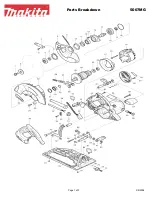
3
2
1
OPERATION
50
ENGLISH
of the workpiece that will pass between the blade and the fence (see Fig. 37).
• Keep your thumbs off the table top. When both of your thumbs touch the front
edge of the table, complete the cut using a push stick. (see Fig. 38)
• The push stick should always be used when the ripped workpiece is 2” (5 cm)
wide or narrower.
• Continue to push the workpiece with the push stick until it passes the blade guard
and clears the rear of the table.
• Never pull the workpiece back while the blade is turning. Turn the switch OFF.
When the blade comes to a complete stop, raise the anti-kickback pawls on
either side of the splitter, if necessary, and then slide the workpiece out.
CAUTION!
Avoid kickback by pushing only on the section of workpiece that will
pss between the blade and the fence.
BEVEL RIPPING
This operation is the same as ripping, except that the bevel angle is set to an angle
other than 0
o
.
CAUTION!
Only cut with the workpiece and the fence on the right-hand side of
the blade.
RIPPING SMALL PIECES
CAUTION!
Avoid injury resulting from contact with the blade. Never make
through-cuts narrower than 3/4” wide.
• It is not safe to rip small pieces. It is not safe to put your hands close to the blade.
In order to ensure your safety, rip the small piece from a large piece.
• When a small width is to be ripped and the hand cannot be safety put between
the blade and the rip fence, use one or more push sticks. Use the push sticks to
hold the workpiece against the table top and the fence, and to push the workpiece
completely past the blade (see Fig. 38)
CROSSCUTTING (FIG. 39)
CAUTION!
To prevent serious injury:
a. Do not allow familiarity or frequent use of your table saw to cause careless
mistakes. Remember that even a fraction of a second of carelessness is enough
to cause a severe injury.
b. Keep both hands away from the blade and the path of the blade.
c. Never attempt to pull the workpiece backward during a cutting operation. This will
cause kickback, and serious injury to the user can occur.
• Remove the rip fence, and place the mitre gauge in one of the grooves on the
table.
• Adjust the blade height so that it is 1/8” (3.2 mm) higher than the top of
the workpiece.
• Hold the workpiece firmly against the mitre gauge, with the blade path in line with
the desired cut location. Move the workpiece to within 1” (2.5 cm) of the blade.
• Start the saw, and wait for the blade (1) to come up to full speed. Never stand
directly in line with the path of the saw blade.
• Keep the workpiece (2) against the face of the mitre gauge (3) and flat against
the table. Slowly push the workpiece through the blade.
• Do not attempt to pull the workpiece backward while the blade is turning. Turn the
switch OFF, and wait until the blade has come to a complete stop before carefully
sliding the workpiece out.
WARNING!
In order to avoid instability, always place the larger surface of the
workpiece on the table when crosscutting and/or bevel crosscutting.
fig.39







































